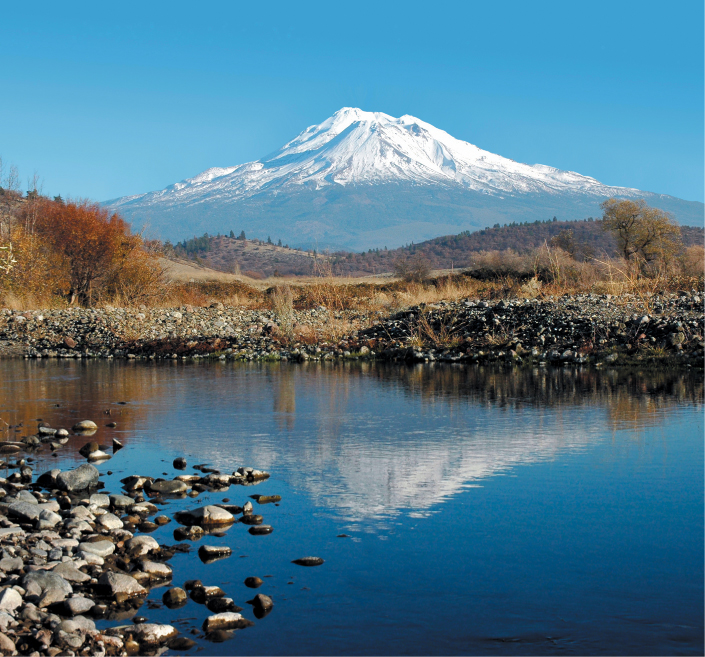Religious Ecology
Religious Ecology

What is the relationship between religion and the natural habitat? How does religion influence our modification of the environment and shape our perception of nature? Does the habitat influence religion? All these questions, and more, fit into the theme of cultural ecology.
Appeasing the Forces of Nature
Appeasing the Forces of Nature
One of the main functions of many religions is the maintenance of harmony between a people and their physical environment. Thus, religion is perceived by its adherents to be part of the adaptive strategy (one of the cultural tools needed to survive in a given environment), and for that reason, physical environmental factors, particularly natural hazards and disasters, exert a powerful influence on the development of religions.
Environmental influence is most readily apparent in animistic faiths. In fact, an animistic religion’s principal goal is to mediate between its people and the spirit-filled forces of nature. Animistic ceremonies are often intended to bring rain, quiet earthquakes, end plagues, or in some other way manipulate environmental forces by placating the spirits believed responsible for these events. Sometimes the link between religion and natural hazard is visual. The great pre-Columbian temple pyramid at Cholula, near Puebla in central Mexico, strikingly mimics the shape of the awesome nearby volcano Popocatépetl, which towers to the menacing height of nearly 18,000 feet (5500 meters).
Rivers, mountains, trees, forests, and rocks often achieve the status of sacred space, even in the great religions. The Ganges River and certain lesser streams such as the Bagmati in Nepal are holy to the Hindus, and the Jordan River has special meaning for Christians, who often transport its waters in containers to other continents for use in baptism (Figure 7.15). Most holy rivers are believed to possess soul-cleansing abilities. Hindu geographer Rana Singh speaks of the “liquid divine energy” of the Ganges “nourishing the inhabitants and purifying them.”

Thinking Geographically
Question 7.16
HYV1FYeVUy6UwA7cWtkzzAKR89+RxPwINOul3B+LG+vxnhUoGG7yEk3DlZ2NYP1PQWS8+HhsAnr6RnC+hbaiRTVQFOkBtl4gDAt1mazdQrSQ8Sw3v8qLysXzw02wnJoKmOfS5tE5PKdpUqT72wN0IL5wRq+Q5Y94w7kq7w==179
Mountains and other high places likewise often achieve sacred status among both animists and adherents of the great religions. Mount Fuji is sacred in Japanese Shinto, and many high places are revered in Christianity, including Mount Sinai. Some mountains tower so impressively as to inspire cults devoted exclusively to them. Mount Shasta, a massive snowcapped volcano in northern California, near the Oregon border, serves as the focus of no fewer than 30 New Age cults, the largest of which is the “I Am” religion, founded in the 1930s (Figure 7.16). These cults posit that the Lemurians, denizens of a lost continent, established a secret city inside Mount Shasta. Geographer Claude Curran, who studied the Shasta cults, found that, although few of the adherents live near the mountain, pilgrimages and festivals held during the summer swell the population of nearby towns and contribute to the local economy.

Thinking Geographically
Question 7.17
UYSW1lJY8AgOPg3MjbQLTse3nYln8UG7oPPavFdR7XPx6oTJq+fxjgroBtftvCmkl6OzLZdvsueCCvMjsqqC9Q==Animistic nature-spirits lie behind certain practices found in the great religions. Geomancy, or feng shui, which literally means “wind and water,” refers to the practice of harmoniously balancing the opposing forces of nature in the built environment. A feature of Asian religions that emphasizes Tao, the dynamic balance found in nature, feng shui involves choosing environmentally auspicious sites for houses, villages, temples, and graves. The homes of the living and the resting places of the dead must be aligned with the cosmic forces of the world in order to assure good luck, health, and prosperity. Although the practice of feng shui dates back some 7000 years, contemporary people practice its principles. Figure 7.17 depicts a high-rise condominium in Hong Kong’s Repulse Bay neighborhood. The square opening in the building’s center is said to provide passage for the dragon that dwells in the hill behind, allowing the dragon to drink from the waters of the bay and return to its abode unencumbered. Some Westerners have also adopted the principles of feng shui. Office spaces as well as homes are arranged according to its basic ideas. For example, artificial plants, broken articles, and paintings depicting wars are thought to bring negative energy into living spaces and so should be avoided.

Thinking Geographically
Question 7.18
Wo/CHlBOxodF7IHx7rqqNGgsW56uyAXp4MdDh85qPHOviwfEsAWHZbs9xiigQgiSCPzFKy/cMpvkya1f7QPCQ0aQvOBIrImY+bPO1NiQAG/6BAVfpE7jMUKVyfS06LVRmJE0Ay2rkaIm9hVi5W8VviQGLyyIvpVpBFTydAkPIZtT+rhMmLKrHyIiVFDR3hzYPqtbKZL7xjqSUcPnqCW+/woI/W0KmNrjSFr8iaoYz6LYIOosejnKCA64eGUA4naYAlthough the physical environment’s influence on the major Western religions is less pronounced, it is still evident. Some contemporary adherents to the Judeo-Christian tradition believe that God uses plagues to punish sinners, as in the biblical account of the 10 plagues inflicted on Egypt, which forced the Israelites into the desert. Modern-day droughts, earthquakes, tsunamis, and hurricanes are interpreted by some as God’s punishment for wrongdoing, whereas others argue that this is not so. Environmental stress can, however, evoke a religious response not so different from that of animistic faiths. Local ministers and priests often attempt to alter unfavorable weather conditions with special services, and there are few churchgoing people in the Great Plains of the United States who have not prayed for rain in dry years.
Ecotheology
Ecotheology
ecotheology The study of the interaction between religious belief and habitat modification.
Ecotheology is the name given to a rich and abundant body of literature studying the role of religion in habitat modification. More exactly, ecotheologians ask how the teachings and worldviews of religion are related to our attitudes about modifying the physical environment. In some faiths, human power over natural forces is assumed. The Maori people of New Zealand, for example, believe that humans represent one of six aspects of creation, the others being forest/animals, crops, wild food, sea/fish, and winds/storms. In the Maori worldview, people rule over all of these except winds/storms.
teleology The belief that Earth was created especially for human beings, who are separate from and superior to the natural world.
The Judeo-Christian tradition also teaches that humans have dominion over nature, but it goes further, promoting the view that Earth was created especially for human beings, who are separate from and superior to the natural world. This doctrine, called teleology, is implicit in God’s message to Noah after the Flood, promising that “every moving thing that lives shall be food for you, and as I gave you the green plants, I give you everything.” The same theme is repeated in the Psalms: “The heavens are the Lord’s heavens, but the Earth he has given to the sons of men.” Humans are not part of nature but separate, forming one member of a God-nature-human trinity.
179
Believing that Earth was given to humans for their use, early Christian thinkers adopted the view that humans were God’s helpers in finishing the task of creation, that human modifications of the environment were God’s work. Small wonder, then, that the medieval period in Europe witnessed an unprecedented expansion of agricultural acreage, involving the large-scale destruction of woodlands and the drainage of marshes. Nor is it surprising that Christian monastic orders, such as the Cistercian and Benedictine monks, supervised many of these projects, directing the clearing of forests and the establishment of new agricultural colonies.
Subsequent scientific advances permitted the Judeo-Christian West to modify the environment at an unprecedented rate and on a massive scale. Some critics argue that this marriage of technology and teleology is one cause of our modern ecological crisis. The Judeo-Christian religious heritage, they believe, has for millennia promoted a view of nature that is potentially far more damaging to the habitat than an organic view of nature in which humans and nature exist in balance. Yet there is considerable evidence to the contrary. For example, in Russia, the Orthodox Church is working to create wildlife preserves on monastery lands. The Patriarch of Constantinople, leader of Eastern Orthodox Christianity, has made the fight against pollution a church policy, declaring that damaging the natural habitat constitutes a sin against God. The Church of England has declared that abuse of nature is blasphemous, and throughout the monotheistic religions, the green teachings of long-dead saints such as Christianity’s St. Francis of Assisi, who treasured birds and other wildlife, now receive heightened attention.
The great religions of southern and eastern Asia, and many animistic faiths, also highlight teachings and beliefs that protect nature. In Hinduism, for example, geographer Deryck Lodrick found that the doctrine of ahimsa had resulted in the establishment of many animal homes, refuges, and hospitals, particularly in the northwestern part of India. The hospitals, or pinjrapoles, are maintained by the Jains.
179
However, real-world practices do not always reflect the stated ideals of religions. Buddhism, like Hinduism, protects temple trees but demands huge quantities of wood for cremations (Figure 7.18). Traditional Hindu cremations, for example, place the corpse on a pile of wood, cover it with more wood, and burn it during an open-air rite that can last up to six hours. The construction of funeral pyres is estimated to strip some 50 million trees from India’s countryside annually. In addition, the ashes are later swept into rivers, and the burning itself releases carbon dioxide into the atmosphere, contributing to the pollution of waterways and the atmosphere. A “green cremation system” is currently under development by a New Delhi–based nonprofit organization. Placing the first layer of wood on a grate and placing a chimney over the pyre can reduce wood use by 75 percent.
